skip to main |
skip to sidebar
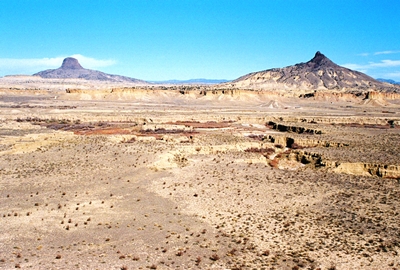
Over the past few years the Río Puerco Valley has become one of my favorite places in New Mexico. About an hour northwest of Albuquerque, with majestic Cabezon Peak always in sight and miles of the Continental Divide Trail close at hand, here you'll find the villages of San Luis, Cabezón, Guadalupe, and Casa Salazar, some of which are essentially ghost towns. No, there aren’t many people around the Puerco Valley anymore and not a lot of its history has been recorded.
However, one person who has done more than any other to ensure that the Río Puerco Valley is not forgotten is historian and folklorist Nasario García. Raised on the banks of the Puerco, Nasario is the subject of a brand new documentary, “Nasario Remembers the Río Puerco,” and following are four of his stories that do not appear in the film, each recollection inspired by photographs from the area.
I’m very proud to feature these stories here and I want to thank Director and Producer Shebana Coelho for making this happen, as well as Nasario García himself, of course. The broadcast premier of “Nasario Remembers the Río Puerco” will be this Thursday, October 12, 2017, at 7PM on New Mexico PBS/KNME Channel 5. I’ve seen the movie and it’s truly wonderful. I highly recommend it to all. For more information, visit Nasario Remembers.
Now, without further ado, City of Dust presents Nasario García and New Mexico’s Río Puerco Valley:
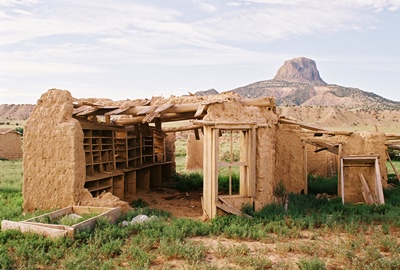
Sal Lovato General Store. Cabezón, New Mexico.
“This store was owned by the Salomón Lovato family. He is one of the contributors to my book, ‘Recuerdos de los Vijeitos.’ You can see where they had different merchandise: canned goods, dried goods and so forth.
“The kind of merchandise they had in these stores was foodstuff that you could not grow, that you could not raise from the land. Here you came and bought, say, lard, even though that wasn't always the case because there was lard from the matanzas. Baking powder, sugar, salt, and some canned goods started coming into existence, as well as dry cereal such as oatmeal. Also, any number of other things—flour, for example. When corn began to become scarce, people would come in the Lovato Store and buy sacks of flour. Those sacks were very important because once the flour was gone the sacks were used to make blouses for the women, blouses for the young girls. In many cases, a young girl would show up at a dance with a rose on the back of her blouse that came from the flour sack. Nobody really looked at you as being odd. That was the moda—fashionable—among many of the families.
“I imagine the store was especially busy on weekends. Of course, a lot of Navajos came from the reservation on weekends. Probably the high point of trading was during the lambing season through the sheering of sheep, which was in May and June. The selling of cattle—those who had cattle—occurred in late September or in October, perhaps even early November. People would make money selling their cattle, selling their sheep. Naturally, that's when they would come to buy a lot of merchandise. But it didn't matter the time of year because many merchants sold on credit. People would pay their bills, say, once or twice a year, whenever they sold their sheep, their wool, their cattle.”
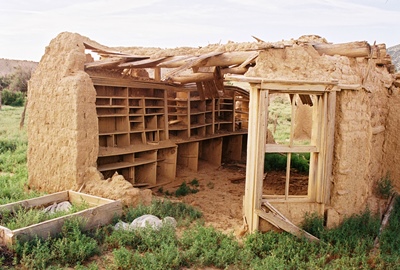
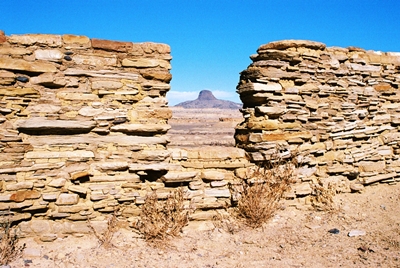
View from Enchanted Mesa Looking Toward Cabezon Peak and Nasario’s Grandpa’s Corral.
“The Enchanted Mesa was right across the Río Puerco from where we lived. That’s the mesa that my paternal grandmother would tell us never to visit because, if we did, we were likely to be turned into goats. My grandmother referred to it as La Mesa Encantada. Many years later, after I left the valley, archaeologists discovered that it was a Chaco Canyon outlier. Now it’s called the Guadalupe Ruins.
“In the evenings, while we were shucking corn, Grandma Lale—her nickname—would tell us stories with the Enchanted Mesa in sight—stories that had to do with the local culture, the local folklore, such as the white donkey, a rarity among donkeys. As she and my Grandpa Lolo, as we called him, told us, they were coming from the placita at night, perhaps after a dance, when suddenly a white donkey appeared and kept pestering the female horse—la yegua—and my grandmother says, as she's telling the story, ‘Look there, I wonder where it came from.’ My grandpa said, ‘I don't know. I know all the donkeys in the valley and I've never seen a white donkey.’ The donkey kept pestering and pestering. ‘Furthermore,’ says my grandpa, ‘there are no white donkeys around.’ My grandmother says, ‘But I am glad this one's here, because a white donkey means good luck. It doesn't mean evil like a black donkey.’
“She would weave these stories, and, in the meantime, we are on pins and needles wondering what's going to happen next. At the end of the story, my grandmother asked my grandfather, ‘Now, truly, what do you think about this white donkey?’ They said they’d turned their heads and the donkey was gone. They never saw it leave. It was stories like this that she liked to share with us grandchildren. She had many, many others.”
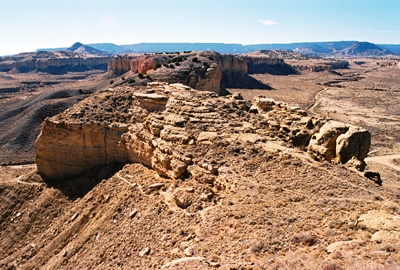
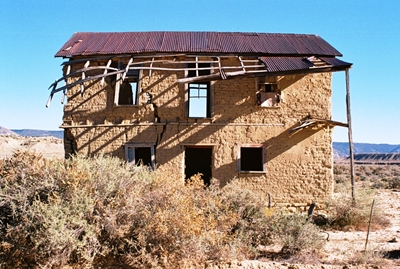
Córdova’s Dancehall. Guadalupe, New Mexico.
“This two-story house was in my village of Guadalupe—Ojo del Padre. The bottom floor was used as a dancehall. This is the only two-story house in the entire Río Puerco Valley that I know of. In fact, today there's probably only a handful left in villages like mine throughout all of New Mexico. This house was built around 1905 by the Juan Córdova family. He was a local merchant. He and his family lived upstairs and downstairs was a store that was periodically turned into a dancehall. There was competition from time to time between this dancehall and the Romero Dancehall. A cousin of mine and I, we were small. I was about seven and my cousin about nine years old. We were supposed to spray water on the dirt floors after every dance because of the dust. Of course, as the men drank more and more and people had more fun, we started bringing in buckets and dousing the floors. By the time the dance was over, these people couldn't move because of all the mud that we had created. My cousin Juan and I had a lot of fun.”
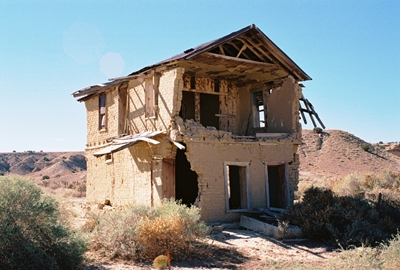
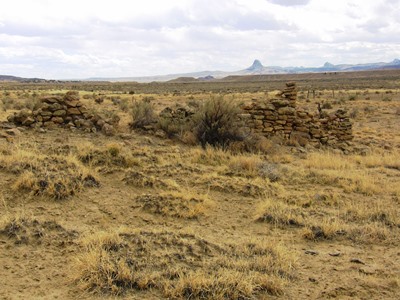
Photo: Shebana Coelho
One-Room Schoolhouse. Guadalupe, New Mexico.
“This was the one-room schoolhouse where I started school. There were about 25 kids from grades one to eight. There were two windows that faced the mesa, but no windows towards the back. That’s where the blackboard was and where the teacher’s desk sat. And towards the middle of the school there was a potbelly stove that the boys had to keep feeding wood into in the winter to keep the room warm. That was our responsibility. The girls had to keep the little barrel of water full. It was wrapped in burlap with a dipper—jumate—hanging from a nail. We all used the same dipper to drink water. We didn’t even wipe it clean the way priests do today when drinking wine from a chalice.
“When I started school here, one teacher taught all the grades and she would line up the boys in one row and the girls in another before entering. There were other times when she would start with the bigger kids. They would walk in first and then the little kids. But most of the time she would line up the younger kids—the first, second and third graders—first, and the older kids were at the back of the room. We had desks that seated two students, usually two boys or two girls.
“The older kids a lot of times would teach the younger how to read, how to do math. So the older kids where helpful. They became teachers. It was very much a communal educational setup. And, believe it or not, we learned. We learned because we learned from one another. Of course, we were supposed to be learning English, but most of us spoke Spanish. When we would read in English we did so with a Spanish accent. We had a book about a dog named Spot. I remember students reading, including myself: “Rrrrrrrrun Espot, rrrrrrrrun.” Because we would pronounce the initial “r” like you would in Spanish and the “s” as in “escribir” —to write. Thus “Rrrrrrun Espot, rrrrrun.”
“And some of the adobes, as you can see, are still here. The school was called, appropriately, “La Mesa School” because of Black Mesa east of the school.”
And so some of the adobes do indeed remain in the Río Puerco Valley, if barely, while many are already gone. Of those shown here, the ruins of the one-room schoolhouse were captured by Shebana Coelho, who was kind enough to allow me to include her shots. Somehow I missed those particular adobe and stone walls myself…for now. Sal Lovato's General Store and Juan Córdova's Dancehall were photographed by me, as were the three views from Enchanted Mesa.
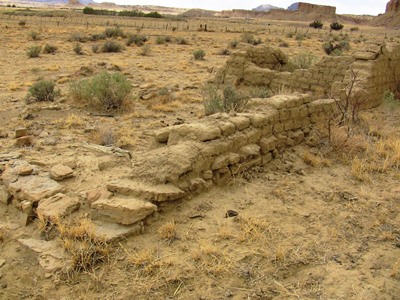 Photo: Shebana Coelho
Photo: Shebana Coelho
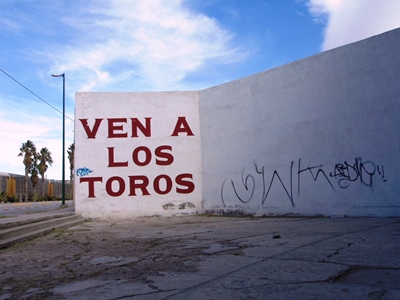
(Ven a los toros - Come to the bulls.)
Blood spills out on the streets
And bodies are missing for weeks
Both sides keeping a close eye
Watching the bullets fly here
On the crystal frontier – Calexico “Crystal Frontier”
While my first day in Ciudad Juárez started with a stroll through the pocked neighborhoods around the International Bridge, followed by a history lesson on the city and Mexico itself, the second began as countless others in Juárez surely have: with a Bloody Mary. But getting to that Bloody Mary required a walk past the 112-year-old bullring, Plaza de Toros Alberto Balderas, the oldest building in the city. A newer but even more famous bullring, Plaza Monumental, was torn down in 2006 to make way for a Walmart. Is it better for a bull to die in a ring or end up as a frozen patty in a warehouse chain?
I won’t answer that question, but I will mention that during the years of greatest violence in Juárez the Plaza de Toros Alberto Balderas remained shuttered, only opening again in 2012. As we were walking past we noticed a couple workers out front of the Plaza de Toros and my tour guide, Rich Wright, asked if we could poke our heads inside. I can’t deny that crouching under the empty stands to peer across the dirt arena at the bull pen door was evocative, but Ernest Hemingway could probably articulate it better than me.
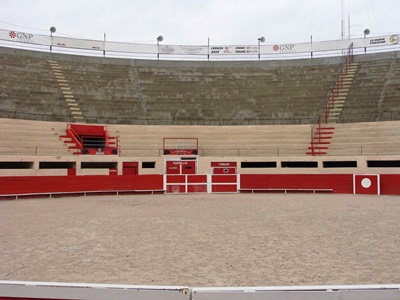
(Plaza de Toros Alberto Balderas.)
Leaving the bullring, we walked a short distance to an unmarked, entirely non-descript building at the corner of Madero and Dieciseis. Opening the door was like stepping into another world, possibly from 1921, when the El Recreo opened. All carved, dark wood and hushed shade, El Recreo, the second-oldest bar in Juárez, after the previously-described Buen Tiempo, is the kind of place you don’t see much anymore, complete with bartender in suit and bow tie.
While the Bloody Mary was delicious, it’s the sotol that may raise an eyebrow at El Recreo. Currently gaining a reputation as the mysterious cousin of tequila and mescal, sotol is made from the plant of the same name, sometimes known as desert spoon, and comes mostly from the state of Chihuahua. Sotol is not an agave, as is often thought, but a member of the asparagus family. The drink is also hard to find; in a city as big as Juárez you will only encounter it in a couple venues. I believe the brand El Recreo serves is El Oro de Coyame and the taste is rough, with plenty of gravitas, the effect perhaps not unlike inhaling campfire smoke that can numb your tongue.
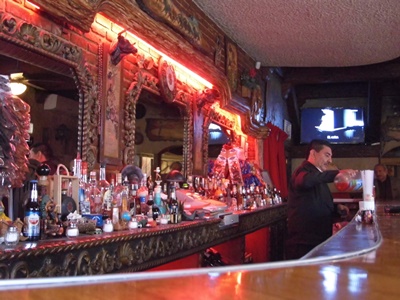
(El Recreo.)
Back out in the glare of midday it was time to put something in our stomachs. Burritos El Negro was recommended by a passerby and turned out to sport a jarring, baseball cap-wearing mascot not far removed from the age of minstrelsy. The restaurant is located in what was once a bustling tourist area, but the tourists stopped coming when the bullets started flying. While the bullets began to slow in 2011, the tourists have not returned. This near-absence of tourism is part of why you can get a massive, phenomenally tasty chile relleno burrito for about a dollar at Burritos El Negro. Follow a Bloody Mary and bit of sotol with two of them and you may regret it.
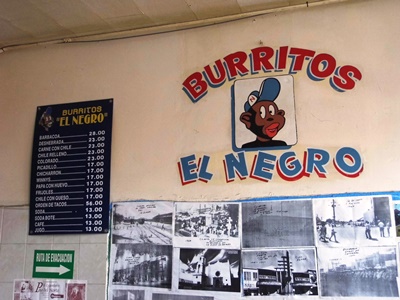
(Burritos El Negro and its unfortunate mascot.)
As we walked down a crowded street after lunch, the noisy bustling heightened by the crunch of a truck driving into the back of a packed bus, a man brushed past me and, in a stage whisper, trilled, “Gggrrriinnnggooo,” not condescendingly, but apparently amused. I mentioned this to Rich, who told me, “We’re like unicorns down here.” Indeed, in two days in Ciudad Juárez I didn’t see another American that looked much like me, not even one hunting for a cheap dentist or discount pharmaceuticals.
I, however, was a tourist, and as such needed a souvenir. What better than a statue of Santa Muerte, or Our Lady of the Holy Death--who is essentially the grim reaper, sickle and all--from the Mercado Cuahtemoc? Said to currently be attracting more devotees than any other religious figure, Santa Muerte began to gain in popularity as drug violence escalated in Mexico and has found a loyal following among narco-traffickers. Not comfortable praying to the Virgin Mary for your cocaine shipment to arrive safely across the border? Make an offering to Santa Muerte. But Santa Muerte is also for those who feel too dirty and down-and-out to appeal to the usual saints. Or maybe you just want to ask for something that an archangel might frown upon. In fact, the Catholic Church frequently tries to remind people that it considers Santa Muerte blasphemous.
Said to currently be attracting more devotees than any other religious figure, Santa Muerte began to gain in popularity as drug violence escalated in Mexico and has found a loyal following among narco-traffickers. Not comfortable praying to the Virgin Mary for your cocaine shipment to arrive safely across the border? Make an offering to Santa Muerte. But Santa Muerte is also for those who feel too dirty and down-and-out to appeal to the usual saints. Or maybe you just want to ask for something that an archangel might frown upon. In fact, the Catholic Church frequently tries to remind people that it considers Santa Muerte blasphemous.
While I wasn't planning to ask much of Santa Muerte, I did want to cover my bases. You can buy statues in various colors depending on what you’re praying for, but I got a tri-colored one. White, gold, and red should, I believe, provide me with health, wealth, and love. Also, while a gringo like me wouldn’t necessarily know that Santa Muerte should come with additional “magic,” Rich luckily did, and made sure I got it. The vendor then proceeded to coat my statue in what appeared to be baby powder before liberally spraying it with something that smelled a little like floral air freshener. The strange, sickly-sweet concoction eventually leaked through two plastic bags and into my backpack, which I found surprisingly disturbing. But I’d been instructed not to release Santa Muerte for 24 hours to ensure the “magic” was properly absorbed, so I didn’t dare transfer Holy Death to a leak-free bag.
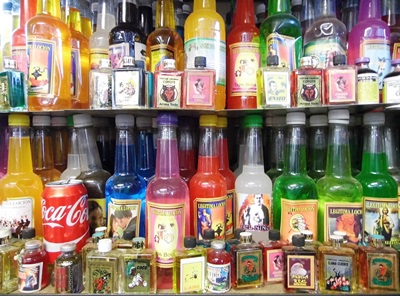
(Magic + Coca Cola.)
With Santa Muerte in tow we walked through an oddly delightful ramshackle alley devoted to Don Quixote, the walls of the buildings covered in graffiti portraying scenes from the 17th century tragi-comedy. Our last stop was El Club 15, named for the number of people that can fit inside. Like El Recreo, it was dark and cool, sold sotol, and featured a well-dressed bartender. The bartender’s name, Chuy, was constantly being called by patrons wanting to have their drinks freshened. Yet, instead of the ornately carved wood of El Recreo, the entirety of the walls and ceiling of El Club 15 were covered in dozens of vintage pin-up photos, bare-breasted women from forgotten eras smiling coyly from nearly every surface. A television in the corner played Pink Floyd’s Live at Pompeii film. Cognitive dissonance, or was Juárez becoming a little bit of everything?
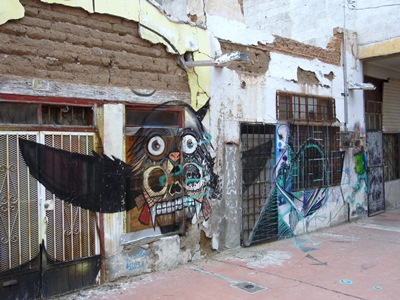
(Not scenes from Don Quixote.)
You see, Live at Pompeii was the first VHS tape I ever watched on a VCR, and I wondered what the thirteen-year-old me would think if he’d known that decades later there’d be that same shaggy Nick Mason pounding those same massive drums. But this time that boy was watching "Careful With that Axe, Eugene" in a tiny bar in a city that a handful of years earlier had been dubbed the Murder Capital of the World, surrounded by mid-twentieth century porn, pressed in on all sides by friendly locals speaking a language he couldn't understand very well, while sipping a Jack and Coke, now had in honor of the late Lemmy Kilmister. He might be kind of confused as to just what sort of path had led here, but I’m fairly certain he’d think Ciudad Juárez, a city trying hard to rebuild itself after some very dark times, was well worth exploring in 2017.
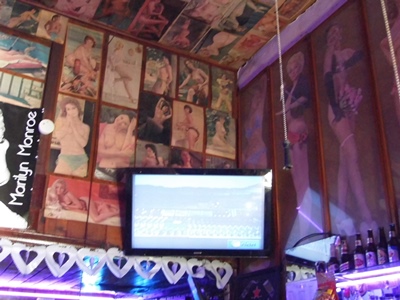
(El Club 15 and its trio of vices.)
Again, many thanks to Rich Wright, who showed me Juárez as I never could’ve seen it otherwise, even if given many years of roaming the streets on my own. I can’t recommend taking one of his walking tours highly enough. More information on those can be found right HERE.

(La vida es muy corta para tener miedo - Life is too short to be afraid.)
Juárez, I had a dream today
The children danced, as the guitars played
And all the violence up and slipped away
Goodnight, Juárez, Goodnight - Tom Russell "Goodnight Juárez"
Tom Russell recorded Goodnight Juárez in the fall of 2010, and by the end of that year 3,111 people would be murdered in a city of about 1.4 million. Ciudad Juárez was already coming to be widely known as the Murder Capital of the World and tourism from the north, for many decades so lively, if admittedly often bacchanalian, had effectively ceased in the few years since cartel activity had begun to spike in 2007.
However, 2010 would represent the bloody peak of brutality and, by 2015, there were just over 300 homicides. While it can’t be said that the violence has up and slipped away--and 2016 did see an uptick in killings--Ciudad Juárez is not the place it was several years ago. Yet most of the world hasn’t heard that, or at least doesn’t believe it, which makes Juárez an utterly fascinating, enchanting, and still, at times, sobering city to visit now.

(Groceries - The Shrapnel.)
This story starts when, while visiting El Paso in 2013, I ran into a man setting the old clock in San Jacinto Plaza. He told me that he’d given walking tours of Juárez for years and was thinking it was finally safe enough to resume them. On a subsequent visit I tried to see if the tours were being offered and, sure enough, there was a webpage touting guided trips to downtown Juárez. “Entertaining! Educational! Fun!” the ad read. And, in the biggest, boldest letters: “SAFE!” That was more than good enough for me. Sadly, it would take another couple years to get myself back again to actually take a tour, but in that time Juárez’s reputation for violence seemed to change almost not at all, even as the death toll continued to decrease.
As it turned out, Rich Wright, who has been running these tours, was not the man I met in the plaza. But he’s been going to Juárez his entire life, including during the years of greatest bloodshed, and, with a mutual acquaintance or two in the Minneapolis music scene of the ‘90’s, I couldn’t have asked for anyone more simpatico. Did I mention my Spanish is hardly serviceable?

(Taqueria el Tropíco.)
We paid our 50 cents to cross the Paso del Norte International Bridge and off we went, stopping to note a spray-painted marker on a train bridge below. This was for Sergio Adrian Hernandez Guereca, a 15-year-old shot there by the U.S. Border Patrol in 2010. A case to decide whether his family can sue is now at the U.S. Supreme Court, and the scrawled “Sergio” was an immediate reminder that battles do continue to rage, even if in 2017 some of the fiercest may be fought in hushed courtrooms and the shadowed halls of government.
Once in Juárez, our first stop was Ignacio Mariscal Street, long known as the infamous red-light district, La Mariscal. Rich pointed to an open plaza temporarily filled with brightly-colored amusement park equipment and recalled it lined with ancient bars, a scene now hard to imagine. The demolition is part of a widespread government effort to destroy the haunts of the cartels and generally clean things up, a process which has seen many historic babies going out with the druggy bathwater.
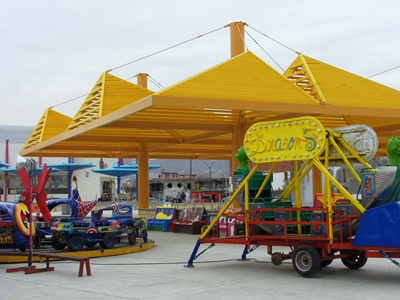
(Amusement of a less traditional sort at La Mariscal.)
Stunning murals covered many of the walls surrounding the plaza, but just before noon on a Friday the amusements were quiet and the plaza itself deserted. So we crossed the walkway to a neighborhood that had not yet been subject to razing or revitalization, which pleased me greatly as among the abandoned buildings was the former home of a brothel called White Lake. It was immortalized in Cormac McCarthy’s “Cities of the Plain,” if moved to a somewhat fictionalized location in the city. Nearby a man lay in a crumbling, concrete doorway sleeping, only his feet protruding into the gathering daylight.
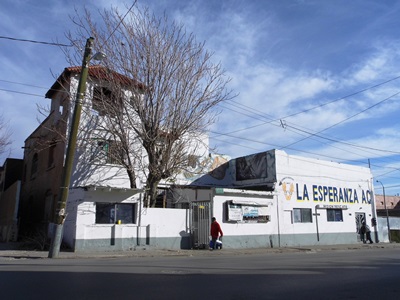
(Former location of White Lake brothel.)
The next stop was the Museo de la Revolución en la Frontera, a wonderful museum housed in the grand old customs building. Tracing the turbulent history of Mexico through the early years of the 20th century, it depicts the frequently harrowing tales of men of great and sometimes dubious intent such as Porfirio Díaz, Pancho Villa, Emiliano Zapata, and Pascual Oruzco, many of which were photographed in the very same building that now describes their legacy.
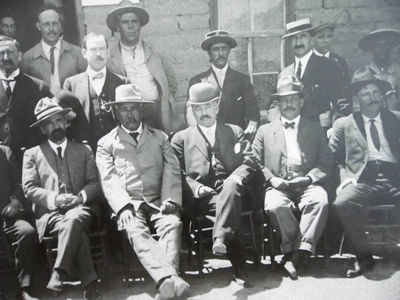
(Museo de la Revolución en la Frontera.)
While much has changed in Juárez, some things have not, and just past noon we found ourselves in Buen Tiempo on Vicente Guerrero, a bar operating continuously since the early 1920’s and thus now the oldest in Juárez, if only barely. With lime-colored walls and No Fumar signs that were hardly being taken as even a remote suggestion, the tequila came in chipped votive candle holders with little crosses on the bottoms and the Indio was cold. People I didn’t know asked me questions I couldn’t always understand and earnestly shook my hand. It all seemed right and proper. From there we headed to Mercado Cuahtemoc and then upstairs for a less liquid lunch. The chips and salsa verde were delicious, as were the chile relleno burritos. At this point, since entering the Buen Tiempo, we probably hadn’t spent 15 Yankee dollars between the two of us.
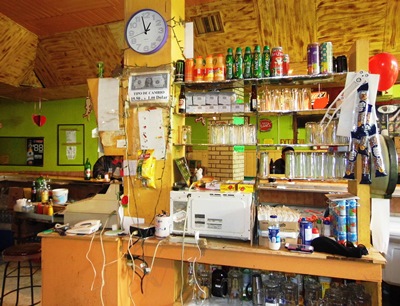
(El Buen Tiempo, the oldest bar in Juárez.)
The afternoon ended with the obligatory stop at the Kentucky Club, said to be the place where the margarita was invented. Once the haunt of the likes of Marilyn Monroe, John Wayne, and Steve McQueen, the Kentucky Club bills itself as world famous and is sometimes referred to as the oldest bar in Juárez. However, it seems that much that is reportedly true about the Kentucky Club may not be quite so and, in fact, the current building is not the original circa-1920 bar. That one was on Dieciseis, over by the train tracks, and not as close to the border. The margarita was good, no doubt about that, but I was perhaps more impressed by the $2.25 price tag.
After giving away whatever coins we had left to people gathered around the bridge, we paid our four pesos to get back to America with plans to return the following day for a “less-structured” tour, part of a lucrative syndication package City of Dust has worked out with El Chuqueño, Rich Wright’s excellent blog on El Paso, its environs, and desert living in general. Details of that second trip across the border will be coming up next.
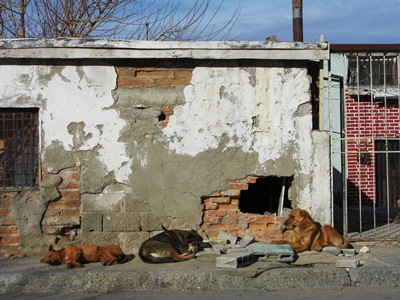
(Los perros de Juárez.)








 Photo: Shebana Coelho
Photo: Shebana Coelho